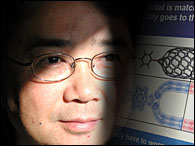Harnessing spin current
A McGill project may hold one of the keys to the future of computing.
 Physics professor Hong Guo
Physics professor Hong GuoPHOTO: Claudio Calligaris |
|
Physics professor Hong Guo's research interest is in nano-electronics, particularly the branch spintronics, which is concerned with harnessing the "spin" of electrons for possible device applications. Guo believes that spin current, in addition to charge current, may one day be used to power computer circuits.
"Charge current is the motion of charge; the movement of electrons creates a current. But electrons have other properties as well: mass, charge and spin. The motion of spin creates a spin current. But spin current is difficult to control, so charge current is used in all electronic devices, up to now."
While spin is a well-known property of electrons, few have tried to tackle the problem of controlling a spin current, because of the equally well-known difficulty involved. But that is changing. Spintronics is a new field which emerged in recent years to tackle the problem of how to control the flow of spin, an essentially random process in typical semiconductors.
As a theoretical physicist, Guo is conducting fundamental research on how to solve this problem -- his work is sponsored by NSERC (Natural Sciences and Engineering Research Council), FCAR (Formation de Chercheurs et l'Aide a la Recherche) and Nano-Québec. Guo is collaborating with Physics professor Jian Wang at University of Hong Kong, a former McGill physicist who left in 1993, and their respective graduate students and postdoctoral fellows. In an upcoming scientific journal article, the team shows why a spin field effect transistor (one run by spin current) is theoretically possible.
"Our paper shows that a spin current can be generated using a rotating magnetic field, which flows out of the device without charge current. The spin current can then be controlled very quickly using a voltage -- this is the spin field effect transistor idea. Today, transistors use voltage to control charge current; we are saying it can do the same to control spin current. We also analyze whether this can be done with existing technology, and we conclude that it can be accomplished in a lab. I believe it will generate interest from experimental people, who will try to make it happen."
The team will also publish another research paper that could create a stir, on a spin cell for spin current.
"We believe it is theoretically possible to generate spin current using a spin cell or spin 'battery'; the idea is that if you want to have a circuit that only works on spin current, you can't have a battery that produces only charge current."
Guo says the advantages of spin are such that harnessing it may become essential to continued technological advances. For one thing, it turns out that spin works in a similar way to the binary code (zeros and ones) that is the basis of computing.
"The spin of electrons is like a little magnet which has a north pole and a south pole. When an electron moves in a device, its spin randomly points in one direction or another. Devices using spin current would have a polarized charge, so that every spin is pointing toward north, for example.
"Digital computers are built with a binary system. In the case of spin, the north pole and south pole is a binary system which is already built in; north is like zero and south is one. So, presumably, we could use every spin to encode information, and the potential for doing so would be vast, unimaginable.
"In the literature on spintronics, there are many ideas about using spin as the binary system to do quantum computing. That is a very interesting perspective on the future."
Thus, spin could allow the continued miniaturization of microelectronics, for a few reasons. Charge current presents physical limits to that process, because the heat it generates can damage tiny components that are too close together.
"For very tiny devices in the future, the problem of heat damage must be solved, and a spin field effect transistor would be helpful in terms of energy dissipation. A spin current does not couple to environment as strongly as charge current, and thus it does not give heat away as easily -- in other words, it does not create friction as easily."
The next frontier of computer miniaturization is nanotechnology. The binary nature of an electron's spin means that a mimic of a computer's zeros and ones exists on a microscopic (nano) scale. Learning to control that process could open the door to quantum computing.
"You cannot go smaller than electrons; because it exists on that scale, this is the ultimate binary system. That is also why many people think that some quantum computing systems in the future will be related to spin.
"Imagine a transistor the size of a molecule; say a single molecule is 10 angstroms long by 3 angstroms across. Today the smallest transistor channel sizes are 1,000 angstroms long by hundreds of angstroms across. That's the kind of size reduction which may be possible. We don't know for sure where this will go because the engineering problems are very difficult to solve, but we do know that the potential is very exciting."

